Saving Our Native Plant Site
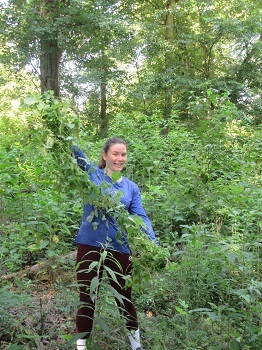 Mara Surovell pulled out long vines of mile-a-minute.
Mara Surovell pulled out long vines of mile-a-minute.
In partnership with the National Park Service, FODMers have been working in the summer of 2020 to control invasive plants in the .065-acre native plant area. Volunteers have hauled out bags of plants like mile-a-minute (Persicaria perfoliata), Japanese stiltgrass (Microstegium vimineum), English ivy (Hedera helix) and porcelain berry (Ampelopsis brevipedunculata).
Invasive plants can outcompete natives and compromise the habitat, so it is important to try to keep them under control. Many native insects and other wildlife depend on the plants with which they co-evolved.
In 2018, FODMers and project partners planted around 4,000 native plants and in 2019 another 400. Examples: riverbank wild rye (Elymus riparius), New York ironweed (Vernonia noveboracensis) and deer tongue (Dichanthelium clandestinum (syn. Panicum clandestinum)). Most of those plants are thriving.
We have installed a Chronolog station at the site so people can take photos of observations there. To help with invasive plants, email This email address is being protected from spambots. You need JavaScript enabled to view it..
Photos by Glenda Booth
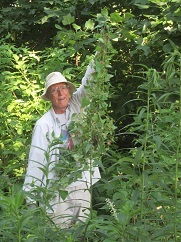 Jim Gearing tackled mile-a-minute, a plant that readily climbs. Jim Gearing tackled mile-a-minute, a plant that readily climbs. |
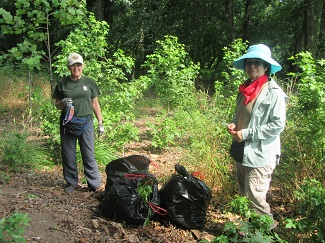 Trudi Hahn and Nancy Herrmann removed and filled several bags of invasive plants on July 16. Trudi Hahn and Nancy Herrmann removed and filled several bags of invasive plants on July 16. |
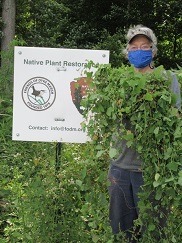 Glenda Booth showed Haul Road passersby examples of mile-a-minute that was abundant in the native plant area in July. Glenda Booth showed Haul Road passersby examples of mile-a-minute that was abundant in the native plant area in July. |
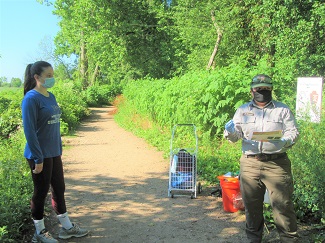 Mireya Stirzaker from the George Washington Memorial Parkway, National Park Service, helped volunteers identify invasive plants and follow coronavirus safety protocols. Mara Surovell, a high school volunteer, was a stalwart. Mireya Stirzaker from the George Washington Memorial Parkway, National Park Service, helped volunteers identify invasive plants and follow coronavirus safety protocols. Mara Surovell, a high school volunteer, was a stalwart. |

 Friends of Dyke Marsh, Inc. is a non-profit 501(c)(3) organization.
Friends of Dyke Marsh, Inc. is a non-profit 501(c)(3) organization.